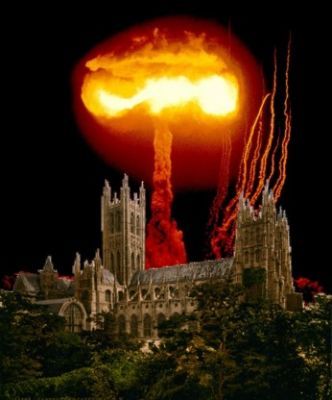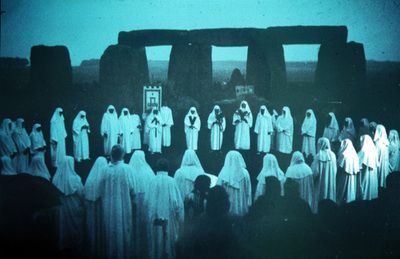Explaining the Episcopalians
 I thought that I would, for obvious reasons, let the whole Anglican warfare thing rest for a few days. However, all good things must come to an end. After all, some of the most powerful forces in American journalism have, in the past week, paused to tell us what it was all about. A few readers have sent me the links to these analysis stories and I didn't want you to think I was ignoring them.
I thought that I would, for obvious reasons, let the whole Anglican warfare thing rest for a few days. However, all good things must come to an end. After all, some of the most powerful forces in American journalism have, in the past week, paused to tell us what it was all about. A few readers have sent me the links to these analysis stories and I didn't want you to think I was ignoring them.
So let's start with a personal confession by yours truly, one linked to an important summary section of Laurie Goodstein's essay, "A Divide, and Maybe a Divorce," in The New York Times. One of the nation's top Godbeat professionals writes:
The liberals insist that what defines Anglicanism is theological diversity, and the conservatives claim Anglicanism requires a commitment to doctrine. The liberals are saying, "Can't we all just get along," while the conservatives are saying, "Can't we all just get in line?"
Hardly a Christian spectacle, the rivalry has been more like a log-rolling contest where the conservatives and the liberals are battling to push each other off a spinning log, while trying to make it look as if their adversaries voluntarily jumped. Now, with the ultimatum, the liberals may need a lot of deft footwork to stay on the log.
Passions run so high that on the more than 150 Anglican blogging sites, the name-calling is vicious. The conservatives call their liberal colleagues "Episcopagans," apostates and revisionists, and refer to themselves as the "guardians of the faith." Liberal bloggers hurl epithets like "ChristiaNazis" and "Neo-con Anglicans."
Let's unpack that first Goodstein paragraph a bit, because I am convinced that the liberals and the conservatives are -- in terms of history -- both right, to some degree.
Anglicanism is built on a compromise between the worship and doctrinal approaches of ancient Christianity and the Reformation. Thus, it is accurate to say that some edgy diversity has always been part of the Anglican package, with Rome and Geneva wrestling for the same altars.
However, the conservatives are right to say that there are doctrinal commitments in the Anglican Book of Common Prayer. Click here to look over a few.
The question, of course, is: Who has the power to decree when the method of the great Anglican Compromise has gone too far? Who gets to draw the theological line? Who says that a bishop has to be a theist? Who says that sex outside of marriage is sin? Who says that the Ten Commandments are more than suggestions?
Is heresy even possible? Is it possible for an Episcopalian to go to far and, in historical terms, be an apostate?
It is in this context that I must confess I have used the term "Episcopagans" in print. However, it is a sign of Anglican diversity that I have only applied this loaded label to people who are, well, both practicing Episcopalians and practicing pagans.
 So I am a literalist in this case. Here is the context of my 2004 use of the term. Or try this link for an old GetReligion post that includes some URLs that are still active.
So I am a literalist in this case. Here is the context of my 2004 use of the term. Or try this link for an old GetReligion post that includes some URLs that are still active.
Our story begins with a liturgy entitled "A Women's Eucharist: A Celebration of the Divine Feminine," posted among the online offerings of the Episcopal Church Office of Women's Ministries. Digital sleuths easily connected this rite to Tuatha de Brighid, a "Clan of modern Druids." Then before insiders could say "Episcopagans," critics found links between its use of milk, honey and raisin cakes and Asherah, Astarte and rituals banned in the biblical book of Hosea.
As a rule, rites connected to Baal are frowned on in Christian churches.
The Internet trail led to the Rev. William Melnyk and his wife, the Rev. Glyn Ruppe-Melnyk, in the Diocese of Pennsylvania. In Druid circles, he is "Oakwyse" and she is "Glispa." Soon, Pennsylvania Bishop Charles E. Bennison, Jr., agreed to discipline the Melnyks -- who publicly repented.
It was crucial to avoid a "where there's smoke, there's fire" response, the bishop told the media. "I will not allow this situation to turn into a witch-hunt of any sort."
A bishop does not, after all, have to hunt witches when he has already found his druids.
To be honest, I do not know how that mini-drama played out, because there were several plot twists after I wrote those words. I think Father Melnyk repented of his repentance, resigned as a priest and became a full-time Druid. Does anyone know?
You get the point, I hope. Perhaps Goodstein is wrong when she assumes that liberal and conservative Anglicans are merely shouting nasty accusations at each other? In her piece, she says that the potential schism in the Anglican Communion resembles the battles over slavery that divided churches in the North and the South. That's the wrong image. This battle is global and actually focuses on the redefinition and the defense of classical, creedal, sacramental teachings in the church. This is the latest round in the battle between premodern Christianity and modernity (not to mention postmodernity).
Can you have a Communion that contains Wiccans and Evangelicals, post-Theists and Charismatics and, to salute the battles of old, hard-shell Calvinists and Anglo-Catholics? Who gets to draw the lines that include or exclude any of these Episcopalians?
Anyway, read the Times piece and respond, if you wish. And there have been similar efforts at NPR, a low-key Q&A at the Los Angeles Times and an analysis by Rachel Zoll of The Associated Press that ends with this sobering statement, which notes that some issues may even transcend doctrine:
Whatever the Episcopal House of Bishops decides over the next seven months, the church can easily survive without the communion. The 2.3 million-member U.S. denomination is relatively small, but it is affluent -- and well situated to continue its missions with other Christians overseas.
In fact, the Anglican Communion itself might suffer more from any broken ties.
A significant chunk of its budget comes from the U.S. church.